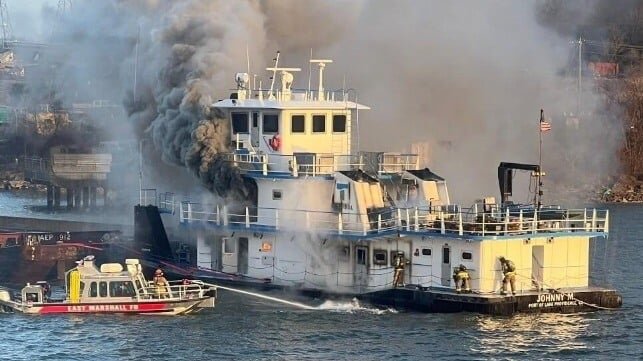Flammable Air Ducts Defeat Towboat’s Firefighting System
Flammable air ducts proved to be the Achilles’ heel in the firefighting efforts aboard the towboat Johnny M during a blaze last year, as reported by the National Transportation Safety Board (NTSB). The incident, which occurred on January 30, 2024, highlighted the critical importance of proper fire safety measures on vessels.
As the crew of the towboat prepared to enter the Kentucky Lock and Dam on the Tennessee River with four barges of rock in tow, a sudden engine room fire broke out, triggering a series of events that ultimately led to the vessel’s extensive damage. Despite the crew’s prompt actions to close dampers and activate the CO2 firefighting system, the fire continued to rage due to the failure of the vessel’s air ducts.
The Fire Incident
At 3:30 AM, alarms sounded aboard the Johnny M as smoke began to fill the wheelhouse. The crew sprang into action, but the fire rapidly escalated, causing catastrophic damage to the port main engine. Despite initial efforts to contain the fire, it reignited at 4:54 AM, prompting the crew to evacuate to a nearby Good Samaritan towboat.
Efforts to combat the blaze from the Good Samaritan vessel were deemed too risky, leading to the arrival of a marine firefighting crew at 7:15 AM. The fire was finally extinguished by 11:30 AM, but the damage to the Johnny M was already substantial, with a total cost of $3 million.
Root Cause Analysis
NTSB investigators identified the vessel’s flexible, fabric air ducts as a major contributing factor to the fire’s spread. These ducts, which supplied air to the main engines, were not insulated or protected, allowing the fire to burn through them and compromise the engine room’s sealed environment. This breach enabled oxygen to enter the space, rendering the CO2 firefighting system ineffective.
According to NTSB’s findings, the lack of covers for the air intake openings on the vessel’s main engines and the use of flammable ducting were critical oversights. Proper insulation, fire-resistant materials, or structural protection for the ducts could have prevented oxygen ingress and enhanced the effectiveness of the CO2 firefighting system.
Conclusion
The incident aboard the Johnny M serves as a cautionary tale for the maritime industry, highlighting the importance of robust fire safety measures and regular inspections of critical systems. By addressing vulnerabilities such as flammable air ducts, vessel operators can mitigate the risk of catastrophic fires and protect the lives of crew members and the integrity of the vessel.
Implementing proactive measures, such as installing covers for air intake openings, using fire-resistant materials for ducting, and ensuring structural protection for critical systems, can significantly enhance a vessel’s firefighting capabilities and overall safety.

